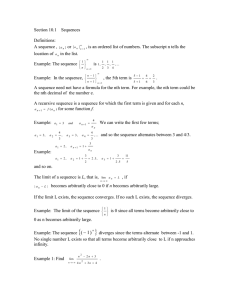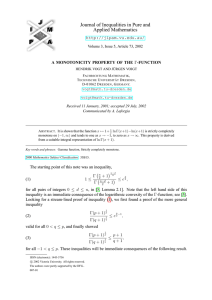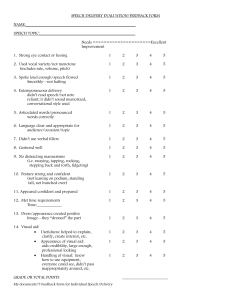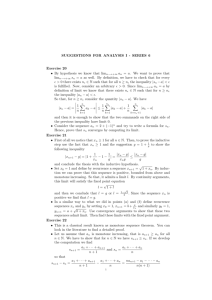MA1132 — Lecture 2 (20/1/2012) 7 ‘
advertisement
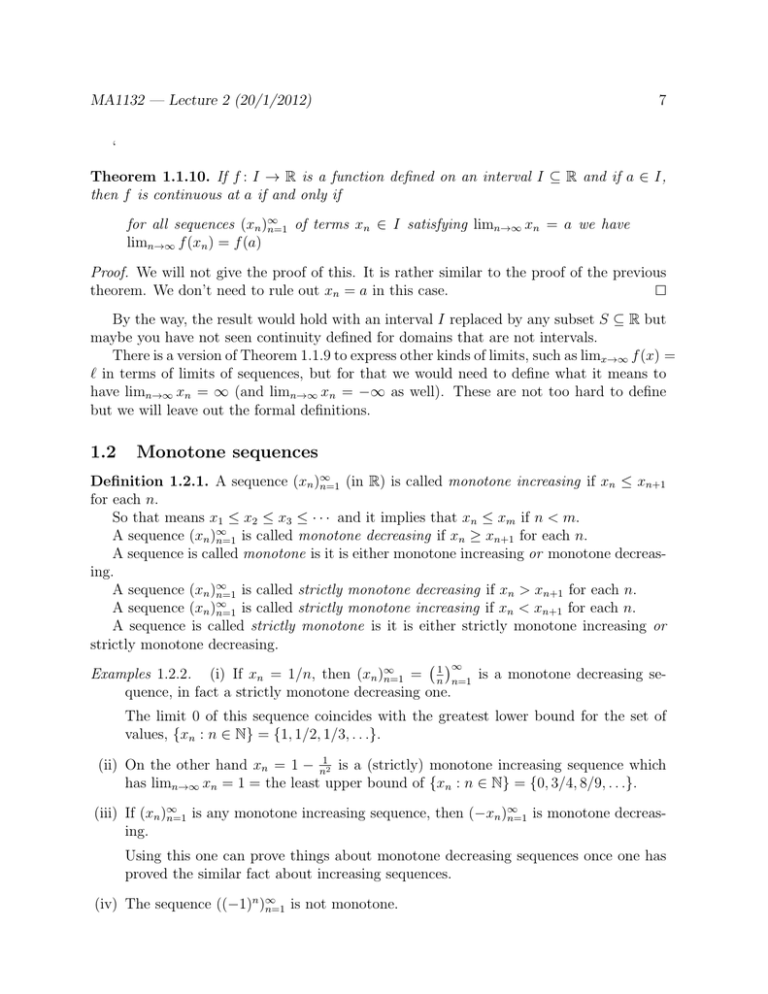
MA1132 — Lecture 2 (20/1/2012)
7
‘
Theorem 1.1.10. If f : I → R is a function defined on an interval I ⊆ R and if a ∈ I,
then f is continuous at a if and only if
for all sequences (xn )∞
n=1 of terms xn ∈ I satisfying limn→∞ xn = a we have
limn→∞ f (xn ) = f (a)
Proof. We will not give the proof of this. It is rather similar to the proof of the previous
theorem. We don’t need to rule out xn = a in this case.
By the way, the result would hold with an interval I replaced by any subset S ⊆ R but
maybe you have not seen continuity defined for domains that are not intervals.
There is a version of Theorem 1.1.9 to express other kinds of limits, such as limx→∞ f (x) =
` in terms of limits of sequences, but for that we would need to define what it means to
have limn→∞ xn = ∞ (and limn→∞ xn = −∞ as well). These are not too hard to define
but we will leave out the formal definitions.
1.2
Monotone sequences
Definition 1.2.1. A sequence (xn )∞
n=1 (in R) is called monotone increasing if xn ≤ xn+1
for each n.
So that means x1 ≤ x2 ≤ x3 ≤ · · · and it implies that xn ≤ xm if n < m.
A sequence (xn )∞
n=1 is called monotone decreasing if xn ≥ xn+1 for each n.
A sequence is called monotone is it is either monotone increasing or monotone decreasing.
A sequence (xn )∞
n=1 is called strictly monotone decreasing if xn > xn+1 for each n.
A sequence (xn )∞
n=1 is called strictly monotone increasing if xn < xn+1 for each n.
A sequence is called strictly monotone is it is either strictly monotone increasing or
strictly monotone decreasing.
1 ∞
is a monotone decreasing seExamples 1.2.2. (i) If xn = 1/n, then (xn )∞
=
n=1
n n=1
quence, in fact a strictly monotone decreasing one.
The limit 0 of this sequence coincides with the greatest lower bound for the set of
values, {xn : n ∈ N} = {1, 1/2, 1/3, . . .}.
(ii) On the other hand xn = 1 − n12 is a (strictly) monotone increasing sequence which
has limn→∞ xn = 1 = the least upper bound of {xn : n ∈ N} = {0, 3/4, 8/9, . . .}.
∞
(iii) If (xn )∞
n=1 is any monotone increasing sequence, then (−xn )n=1 is monotone decreasing.
Using this one can prove things about monotone decreasing sequences once one has
proved the similar fact about increasing sequences.
(iv) The sequence ((−1)n )∞
n=1 is not monotone.
MA1132 — Lecture 2 (20/1/2012)
8
Theorem 1.2.3 (a variation on the least upper bound principle). If (xn )∞
n=1 is any monotone increasing sequence with an upper bound in R, then limn→∞ xn exists in R.
Proof. The idea is to show that the limit must be the least upper bound of the set {xn :
n ∈ N}.
Recall that an upper bound for the set is a number u ∈ R so that xn ≤ u for each n.
A least upper bound U is what it says — an upper bound so that no smaller number is an
upper bound.
We won’t give the proof very carefully but the idea is that limn→∞ xn = U = the least
upper bound (which must exist because of the least upper bound principle). Given ε > 0,
U − ε is too small to be an upper bound and so there is N with xN > U − ε. For n > N
we have xn ≥ xN > U − ε but also xn ≤ U , which implies |xn − U | < ε.
Corollary 1.2.4. If (xn )∞
n=1 is any monotone decreasing sequence with a lower bound in
R, then limn→∞ xn exists in R.
Remark 1.2.5. Monotone sequences are then somewhat simpler that general sequences, at
least in terms of whether they have limits or not. If they are bounded they do have limits.
If a monotone increasing sequence (xn )∞
n=1 is not bounded (above — it is bounded below
by x1 ) then in fact limn→∞ xn = ∞. We skipped the formal definition of infinite limits but
maybe you can understand it without the formalities. This tells us how to explain the long
run behaviour of the sequence fairly well. We don’t consider sequences with infinite limits
as being as well-behaved as those with ordinary finite limits.
The term ‘convergent sequence’ is usually reserved for those with finite limits.
1.3
Series
A series (of real numbers) is in fact just a sequence (xn )∞
n=1 but we use the word ‘series’
when we are thinking of adding up the infinite list of numbers, to try and make sense of
x1 + x2 + x3 + · · ·
Such an infinite sum does not make sense without a definition of what it might mean.
There is no theoretical difficulty with any finite sum (though there could be a practical
difficulty if the number of terms is really huge).
P
∞
Notation 1.3.1. We write ∞
n to indicate a sequence (xn )n=1 considered as a series.
n=1
Px∞
The partial sums of a series n=1 xn are the finite sums
s n = x1 + x2 + · · · + xn =
n
X
xj
j=1
P∞
Definition 1.3.2. A series n=1 xn is called convergent
if the sequence of its partial sums
Pn
has a finite limit, that is if limn→∞ sn = limn→∞ j=1 xj exists in R.
MA1132 (R. Timoney)
January 19, 2012


